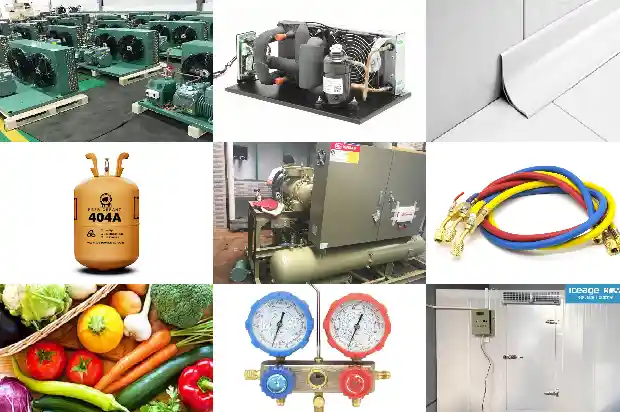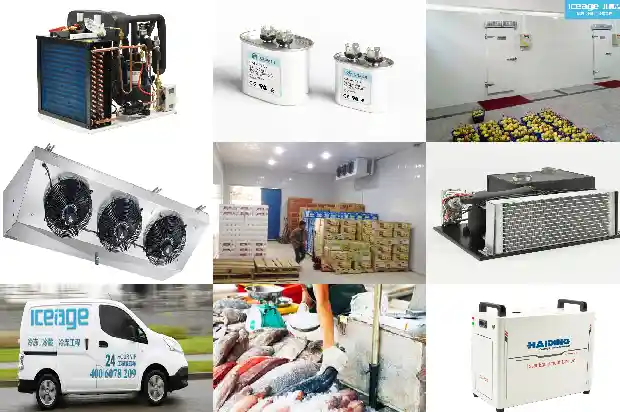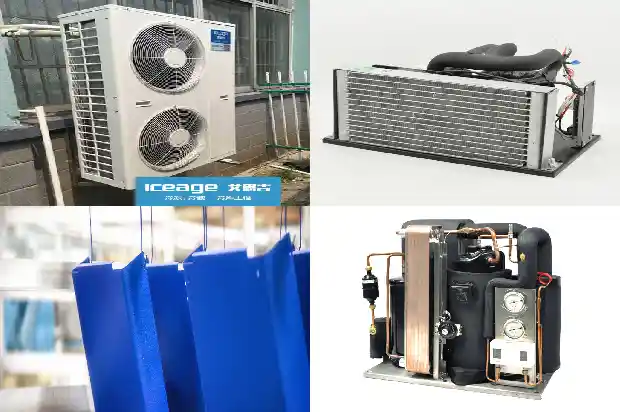Cleaning Methods for Different Types of Condensers in Refrigeration Devices
2025-01-01
Whether it is an air - cooled unit or a water - cooled unit, after a certain period of use, the refrigeration performance will decline. This is usually due to the dirtiness of the condenser or the formation of scale inside, which leads to a decrease in heat exchange efficiency. At this time, it is necessary to consider cleaning and maintaining the condenser to avoid poor heat dissipation.
According to the different cooling media, condensers are divided into air - cooled condensers and water - cooled condensers. Among them, water - cooled shell - and - tube condensers made of copper tubes generally adopt chemical cleaning methods; water - cooled shell - and - tube condensers made of steel tubes generally adopt mechanical cleaning methods; for air - cooled condensers, brushing and blowing methods can be used for cleaning.
Purposes of Cleaning the Condenser:
(1) During the cyclic use of the cooling water in the water - cooled condenser, due to factors such as temperature changes, evaporation, and concentration, calcium bicarbonate, magnesium bicarbonate, etc. in the water decompose to form calcium carbonate and magnesium carbonate, which separate from the water and deposit on the inner wall of the condenser or pipes to form scale. In addition, dust, bacteria, etc. mixed in the air also adhere to the equipment. Over time, the scale layer thickens, reducing the pipe diameter, decreasing the water volume, increasing the heat transfer resistance, and significantly reducing the heat exchange efficiency of the condenser. Generally, the water - cooled condenser should be cleaned once a year.
(2) The air - cooled condenser uses air as the cooling medium. Since there is dust in the air, and sometimes there is also oil mist, when the air flows, the dust and oil mist easily adhere to the surface of the condenser, blocking the fin gaps, increasing the condensing pressure, reducing the refrigeration capacity, and making the temperature in the cold room drop slowly. Therefore, it is necessary to regularly remove the dust from the condenser.
(1) During the cyclic use of the cooling water in the water - cooled condenser, due to factors such as temperature changes, evaporation, and concentration, calcium bicarbonate, magnesium bicarbonate, etc. in the water decompose to form calcium carbonate and magnesium carbonate, which separate from the water and deposit on the inner wall of the condenser or pipes to form scale. In addition, dust, bacteria, etc. mixed in the air also adhere to the equipment. Over time, the scale layer thickens, reducing the pipe diameter, decreasing the water volume, increasing the heat transfer resistance, and significantly reducing the heat exchange efficiency of the condenser. Generally, the water - cooled condenser should be cleaned once a year.
(2) The air - cooled condenser uses air as the cooling medium. Since there is dust in the air, and sometimes there is also oil mist, when the air flows, the dust and oil mist easily adhere to the surface of the condenser, blocking the fin gaps, increasing the condensing pressure, reducing the refrigeration capacity, and making the temperature in the cold room drop slowly. Therefore, it is necessary to regularly remove the dust from the condenser.
Scope of Application: For water - cooled condensers made of copper tubes, due to the thin wall of the copper tubes and the low hardness of the material, mechanical descaling methods such as using a scraper are not suitable. Chemical descaling methods are generally used.
I. Operation Preparation
- Preparation of Tools and Equipment
Fitter tools, rubber gaskets (rings), engine oil, clean rags, water pipes, vernier calipers (or inside micrometers), spiral nylon wire brushes, special descaling agents, etc. - Preparation of Protective Equipment
Protective glasses, gloves, etc. - Preparation for Shutting Down the Equipment
a) Stop the operation of the refrigeration system and close the inlet valve of the condenser in the cold storage.
b) After closing the valve, promptly drain the excess water inside the refrigeration system. - Select a suitable cleaning agent and prepare the cleaning agent according to the size of the equipment to be cleaned and the degree of dirt.
II. Operation Steps
- To ensure the best cleaning effect, first set up two temporary circulation systems on the inlet and outlet water pipes of the condenser. This circulation system can remove the drain valve, safety valve, pressure gauge, etc., and then connect them to an external - pipe circulation pump through hoses.
- Pre - rinse with clean water: After making the corresponding preparations, use clean water with a relatively high flow rate to circulate and rinse twice. Try to wash away the sediment in the system and the loose impurities attached to the inner wall of the pipe, etc., to save the amount of descaling agent and prepare for the next step of descaling.
- Cleaning with descaling agent: Add the high - efficiency, safe, and environmentally friendly professional descaling agent to the circulating water according to the proportion specified in the instruction manual, dissolve it, and then use a pump to fill it from the lowest part of the condenser. Let it circulate and soak for about 3 - 5 hours to thoroughly clean the scale inside the condenser.
- Second rinse with clean water: After the dirt inside the condenser is cleaned, promptly drain the sewage and replace it with clean water for rinsing again.
- Scrubbing with a brush: After the entire cleaning process is completed, it is also necessary to open the end plates of the condenser and use a brush to pull back and forth inside the copper tubes of each condenser to remove the dirt and scale on the inner wall of the copper tubes, making them clean as new, shiny, and non - corrosive.
- Rinse with clean water: After cleaning, promptly drain the sewage, rinse repeatedly with clean water, and then cover the end cover of the condenser to restore it to its original state.
- Passivation or pre - film: Add the pre - film agent and circulate for about 10 - 20 minutes, soak for 24 hours, and then drain the sewage to form a protective film inside the copper tubes, prevent oxidation, and slow down scale formation.
- Record: Record the working time, cleaning process, and results. The equipment user signs for confirmation.
III. Precautions:
- Operators should wear gloves and goggles, hold the operating equipment firmly, and control the advancing speed of the scraper.
- When disassembling the end cover, do not strike violently and avoid large vibrations to prevent damage to the equipment.
- When descaling for the first time, the diameter of the selected scraper should be smaller than the inner diameter of the heat - exchange tube to prevent damage to the tube wall. Then, use a scraper with a diameter close to the inner diameter of the tube to descale again.
- After descaling, conduct an air - tightness test on the condenser. It can be put into use again only when the air - tightness is good.
"Mechanical Cleaning Method for Heat Exchangers with Steel Cooling Tubes"Scope of Application: The special scraper descaling method is applicable to water - cooled condensers with steel cooling tubes.
I. Operation Preparation
- Preparation of Tools and Equipment
Fitter tools, rubber gaskets (rings), special scrapers, engine oil, clean rags, water pipes, vernier calipers (or inside micrometers), etc. - Preparation of Protective Equipment
Protective glasses, gloves, etc. - Preparation for Shutting Down the Equipment
c) Stop the operation of the refrigeration system and close the inlet valve of the condenser in the cold storage.
d) After closing the valve, promptly drain the excess water inside the refrigeration system.
II. Operation Steps
- Disassemble the end covers on both sides of the water - cooled shell - and - tube condenser: Use a screwdriver to draw two symmetric lines at the left and right end covers of the condenser respectively. Use tools to remove the end covers. When disassembling, use the diagonal disassembly method. Place the removed bolts in order, and place the removed end covers upright on the workbench or the ground. Pay attention not to damage the rubber gaskets and make good coding and marking.
- Install the scraper: Connect one end of the special scraper to the flexible shaft and the other end to the motor shaft.
- Descaling: Insert the scraper into the tube along the direction of the heat - exchange tube.

Start the motor to make the scraper roll and scrape inside the tube. At the same time, rinse with tap water to make the scraped scale and other debris be washed away by the water pressure.
- Inspection: From the water - inlet side of the condenser, touch the inside of the heat - exchange tube with your finger. If the inner wall is smooth, it is clean. At the same time, use a vernier caliper to measure and compare the inner diameters of each heat - exchange tube. Check the inner diameter of the heat - exchange tube through sensory inspection and measurement with a measuring tool. End the cleaning when it meets the requirements. If it does not meet the requirements, repeat steps 3 and 4 until it is qualified.
- Install the end cover: Install the left and right end covers on the condenser according to the principle opposite to the disassembly of the end cover. Check the gaskets. If the gaskets are damaged, replace them with new ones. Align the positions of the left and right end covers with the pre - drawn scale lines and fasten them. If necessary, use lifting equipment, wooden sticks, or rubber hammers to tap and align them. Finally, use the diagonal tightening method to tighten the end - cover bolts.
- Flush the condenser: Connect the mechanically descaled condenser to the system, start the water pump, and run it for 10 - 20 minutes, then drain the water. Flush it several times in the same way until the flushed water is clean.
- Record: Record the working time, cleaning process, and results.
The equipment user signs for confirmation.
III. Precautions:
- Operators should wear gloves and goggles, hold the operating equipment firmly, and control the advancing speed of the scraper.
- When disassembling the end cover, do not strike violently and avoid large vibrations to prevent damage to the equipment.
- When descaling for the first time, the diameter of the selected scraper should be smaller than the inner diameter of the heat - exchange tube to prevent damage to the tube wall. Then, use a scraper with a diameter close to the inner diameter of the tube to descale again.
- After descaling, conduct an air - tightness test on the condenser. It can be put into use again only when the air - tightness is good.
I. Operation Preparation:
- Preparation of Tools and Equipment
Clean rags, water pipes, cleaning agents, brushes, fin combing tools, etc. - Preparation of Protective Equipment
Protective glasses, gloves, etc. - Preparation for Shutting Down the Equipment
Stop the operation of the refrigeration system and protect the fan motor part to prevent water and debris from entering.
II. Operation Steps:
- Blowing: Use compressed air or nitrogen to blow off the attachments on the surface of the condenser. For heavier parts, brush them off with a brush first and then blow them off.
- Scrubbing: For areas that cannot be blown off with compressed air, use a special cleaning agent (spray - type heat exchanger cleaning agent), spray it on the heat sink for a while and then rinse it with water. For places where spraying is not convenient, use warm water and cleaning agents to scrub with a brush. After scrubbing, rinse with water.
- After cleaning, conduct an air - tightness test on the condenser. It can be put into use again only when the air - tightness is good.
III. Precautions:
Pay attention to protecting the fins, heat - exchange tubes, etc. Do not scrape or strike them with hard objects.
Pay attention to protecting the fins, heat - exchange tubes, etc. Do not scrape or strike them with hard objects.
In general, the cleaning and maintenance of air - cooled condensers is usually to use compressed air to blow the dust off the condensing fins. When there is more dirt, a non - corrosive cleaning agent can be used to clean the condenser. The cleaning and maintenance of water - cooled condensers mainly focuses on removing scale. For bare coil condensers and some double - pipe condensers, acids or other chemical descaling agents are usually circulated in the condenser to achieve the purpose of removing scale. The scale on the outer - layer coils of evaporative condensers can be removed with tools, and the inner - layer coils can be removed with acids or other chemical descaling agents. The descaling of shell - and - tube condensers generally adopts mechanical methods, such as using pneumatic or electric rotary descaling tools, or using a hard brush or a scraper of the appropriate size to pass back and forth inside the water pipe to remove the dirt. It should be noted that vertical shell - and - tube condensers can be descaled while the refrigeration system is running, while horizontal shell - and - tube condensers must be descaled when the refrigeration system is shut down.
Related Articles
- Cleaning Procedures and Methods for Cooling Towers and Heat Exchangers
- Introduction to the Cleaning Processes and Methods of Heat Exchangers and Cooling Towers
- Cleaning Methods for Refrigeration Equipment
- Introduction to Inspection and Handling Methods for Refrigerant Leak in Cold Storage
- Three Common Methods for Removing Water Scale from Water - cooled Condensers
- Reasons for Frost Formation in Cold Storage and Defrosting Methods
- Maintenance Methods for Small Modular Cold Storage Failures
- Common Cold - chain Storage Methods for Fruit and Vegetable Cold Storage
- Why Should Refrigerant Be Filled in Liquid Form? What Are the Filling Methods?
- For Computer Room Air Conditioners, Besides Air - cooled and Water - cooled, What Other Cooling Methods Are There?
- Maintenance Methods for Faults in Screw Refrigeration Air - conditioner Compressors
- Maintenance Methods for Refrigerant Leak in Air - conditioner Outdoor Unit
- Common Faults and Troubleshooting Methods of the Moving Mechanism of Piston Compressors
- Are you familiar with the detection and maintenance methods of air conditioner components?
- What are the precooling methods after the installation of cold storage?
- The Significance of Subcooling Degree in Refrigeration Systems and Methods for Achieving Subcooling
- Common Operating Faults and Treatment Methods of Centrifugal Compressors
- Methods for Mold Removal in Cold Storage
